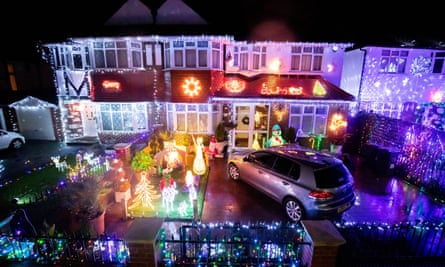Avril and Christopher Rowlands planted a tree in their front garden in 1978 after bringing it home on the roof rack of their white Mini. Now, the £6 tree is a 50ft high local landmark in their village of Inkberrow, Worcestershire, towering over the house and decorated with 1,100 lights using a cherrypicker each festive season.
Amid a global climate crisis, eyewatering energy bills, and concerns about power outages caused by Russia’s decision to throttle supplies of gas to Europe, there is a question about whether these ostentatious, power-munching displays are still in keeping with the national mood. But the Rowlands are just one of the country’s small army of Christmas lights enthusiasts determined dig deep to switch on their displays as usual this year.
Last January, Avril received a concerned call from her supplier, Green Energy, as staff were surprised to see the rise in her December bill. On explaining, they gave her a £100 credit to cover the extra tree light costs and agreed to match it again his year. Last month, her bill, which included government support, was £122 and she expects December’s to be far higher.
Did she consider scaling back the five-hour-a-day display? “I couldn’t do that, you have to do it properly. People start asking me in August about the lights. Even when Chris had a heart attack in 2011, people said: ‘How is he? You’re still going to do the Christmas lights this year aren’t you?’ We’ve done it every year, even during the pandemic because it’s like a beacon of hope.”
She says LEDs wouldn’t work on the tree and “we under-run the lights to make the bulbs last longer and give a magical effect”. Avril, a retired TV writer, holds a switch-on event each year to raise money for charity (this year, a local food bank).
David Clarke has lived in Lower Morden Lane for three decades. It has been named London’s “most Christmassy street” with the majority of homes decked out each year. Clarke says his most ambitious project was a six-metre-high scaffolding tower decorated as a candle, which almost smashed three cars when it blew down 20 years ago. He says he won’t look at his energy bill this year, but may turn his timer switches to go off earlier. “I usually leave them on until midnight which is not necessary because it’s mostly for the kids. It’s been such a gloomy year, we’ve got to light it up and bring joy to people,” he says.
 View image in fullscreenChristmas light displays on houses in Lower Morden Lane, south London. Photograph: Aaron Chown/PA
View image in fullscreenChristmas light displays on houses in Lower Morden Lane, south London. Photograph: Aaron Chown/PA
Jane*, a homeowner in south London, says she and her husband have decided not to buy one another presents this year to cover the increase in the cost, which is still modest at an estimated £110, against £20 last year. “Our main concern was upsetting people by having a light display. We are affected by the rises in inflation, gas and electricity and are due to renew our mortgage in 2024 so we are concerned about the current climate and the impact on our finances, but this cost at Christmas won’t affect our ability to pay the bills.
“We hope that our Christmas lights won’t be seen in poor taste during this cost of living crisis. These times can feel bleak and if our house sparkling brings any joy it will be worth it, in spite of the extra costs.”
It’s not just homeowners who have tough decisions to make, many local councils and community groups are closely examining their plans this year.
On Oxford Street, the country’s most famous Christmas lights will glow from 3pm to 11pm, rather than 24/7 this year. The New West End Company, which represents property owners in the tourist hotspot, said energy consumption will be cut by two-thirds from last year, and 300,000 LED lights, which are 75% cheaper than standard bulbs, will be used. In Europe, Christmas markets and illuminations have been scaled back and seasonal ice rinks ditched.
Ely council in Cambridgeshire said it could not justify spending its usual £9,000 on a switch-on event, with Budleigh Salterton in Devon and Guildford in Surrey following suit. Guildford borough council leader Joss Bigmore said he “cannot afford or justify the value for money for such an additional significant cost”.
skip past newsletter promotion
Sign up to Down to Earth
Free weekly newsletter
The planet’s most important stories. Get all the week’s environment news – the good, the bad and the essential
Enter your email address Enter your email address Sign upPrivacy Notice: Newsletters may contain info about charities, online ads, and content funded by outside parties. For more information see our Privacy Policy. We use Google reCaptcha to protect our website and the Google Privacy Policy and Terms of Service apply.
after newsletter promotion
 View image in fullscreenChristmas lights in Mousehole in Cornwall. Photograph: Andrew Ray/Alamy
View image in fullscreenChristmas lights in Mousehole in Cornwall. Photograph: Andrew Ray/Alamy
The picturesque fishing village of Mousehole hosts one of the largest illuminated displays in Cornwall, which will next year reach their 60th anniversary.
Its stunning displays are cast out into the harbour, which is the focal point of the village. Reflections of illuminated whales and the Loch Ness Monster shimmer in sea water at night. Peter Taylor, the chairman of Mousehole Harbour Lights, says: “We have of course been aware of the environmental impact of electricity consumption for several years and its rapidly escalating price brings that into even sharper focus.” As a result, the lights will be switched off an hour earlier, at 10pm, this year.
He says 80% of the display is now LEDs, which are more efficient and last much longer at 20,000 to 50,000 hours. The cost of LEDs is now closing in on that of incandescent bulbs. Taylor says they are lower voltage so safer for the public and “much more resilient to the rough and tumble of life on the street and the rigours of Cornish coastal weather”.
He says incandescents will be fully phased out next year. Taylor, who is raising funds for a storage building for the displays, adds: “At the other end of the spectrum, we have a large Celtic Cross sited on a nearby offshore island which is entirely solar powered, via lithium iron phosphate (LiFePO) batteries and radio linked to shore for switching.”
*Name has been changed





